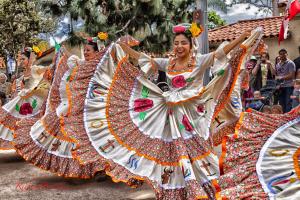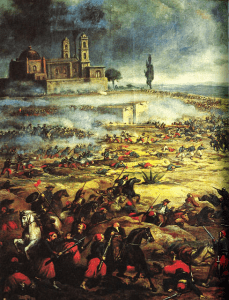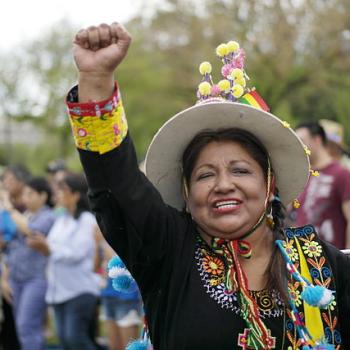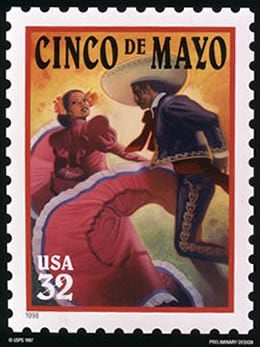WHY CINCO DE MAYO MATTERS
A Meditation on the Places In Between Places
James Ishmael Ford
Today is Cinco de Mayo. It’s one of our more peculiar civic holidays. Out on the inter webs, if you’re moving in circles similar to mine, you’re probably inundated with memes and video clips all making sure you know that today is not Mexican Independence Day. Good information. True fact.
Unfortunately, the presentations are largely without nuance. Lots of finger waging, especially about the beer and college kids and some a bit older, wearing sombreros while engaging in conspicuous swilling of alcohol. Not a lot of love out on those interwebs for this holiday. And, don’t get me wrong, the sombreros are at the very least tasteless, and given the givens of our times, slip into offensiveness of an ugly sort.
However, Cinco de Mayo is a many splendored thing. It’s a subject really worth knowing a bit about. I’ll visit several in our time together. This said, mostly Cinco de Mayo reminds me of the “Day of the Refugios,” a poem by Alberto Rios. He’s addressing another holiday. But the point within it, I believe, sings a profound truth, and one that fits Cinco de Mayo to a “t.” We heard part of that poem as one of this morning’s “readings.” Here’s the whole thing.
I was born in Nogales, Arizona,
On the border between
Mexico and the United States.
The places in between places
They are like little countries
Themselves, with their own holidays
Taken a little from everywhere.
My Fourth of July is from childhood,
Childhood itself a kind of country, too.
It’s a place that’s far from me now,
A place I’d like to visit again.
The Fourth of July takes me there.
In that childhood place and border place
The Fourth of July, like everything else,
It meant more than just one thing.
In the United States the Fourth of July
It was the United States.
In Mexico it was the día de los Refugios,
The saint’s day of people named Refugio.
I come from a family of people with names,
Real names, not-afraid names, with colors
Like the fireworks: Refugio,
Margarito, Matilde, Alvaro, Consuelo,
Humberto, Olga, Celina, Gilberto.
Names that take a moment to say,
Names you have to practice.
These were the names of saints, serious ones,
And it was right to take a moment with them.
I guess that’s what my family thought.
The connection to saints was strong:
My grandmother’s name–here it comes–
Her name was Refugio,
And my great-grandmother’s name was Refugio,
And my mother-in-law’s name now,
It’s another Refugio, Refugios everywhere,
Refugios and shrimp cocktails and sodas.
Fourth of July was a birthday party
For all the women in my family
Going way back, a party
For everything Mexico, where they came from,
For the other words and the green
Tinted glasses my great-grandmother wore.
These women were me,
What I was before me,
So that birthday fireworks in the evening,
All for them,
This seemed right.
In that way the fireworks were for me, too.
Still, we were in the United States now,
And the Fourth of July,
Well, it was the Fourth of July.
But just what that meant,
In this border place and time,
it was a matter of opinion in my family.
And then there’s Cinco de Mayo.
Now, I think as we consider holidays of any sort, but especially those with a particular ethnic element we move into powerful and dangerous territory. We move into liminal spaces. And if we are willing to go along, we will come to a place where our dreams and our actions meet. And, we come to a place where dreams move freely from body to body, joining us in some mystery.
That said, I feel some discomfort at how this particular holiday has become the Mexican St Patrick’s Day. And I mean that with all the ills that follow that sad degeneration of someone’s largely religious holiday mutated into shamrocks and green beer. Except now with sombreros, beer, and margaritas.
Don’t get me wrong, lift a margarita toast if you want. Or, green beer on Saint Patrick’s. Not that big a deal. Just be a little sensitive about what might hurt or offend. You know, common decency. But, also this: there’s something vastly more wonderful in this holiday for those willing to dig a tad deeper. And, then even more if we dig beyond that.
First, as we’ve already said it is not Mexican Independence. That’s observed on September 16th. Cinco de Mayo marks a day decades later. It marks the Battle of Puebla, when a poorly armed Mexican army defeated a much larger, by most estimates actually twice their size, better trained French army.
Here’s an interesting fact. Since the war where that battle was central, no country within the Americas has suffered an invasion from Europe. You could with considerable justice call it our Pan-American Independence Day. And, me, I think that’s something worth celebrating.
Alaso, there’s more within this specific fact of that defeat of a French army. For one thing many scholars believe that if France prevailed in that battle there was a strong likelihood they would have later intervened in the American Civil War. Probably on the side of the Confederacy in order to break the Union blockade, which was playing havoc with French manufacture. Another reason we in the good old USofA have serious reason to celebrate this day.
(And, just because it is cool to know, the leader of that ragtag Mexican army who put the last period on European invasions of our hemisphere, General Ignacio Zaragoza was born in what we today call the state of Texas. So, we can say he is ours, here, as well. Whether we are Mexican or from the States we can claim him.)
If you’re looked into it you know how like for St Patrick’s Day, which has not historically been a major holiday in Ireland, Cinco de Mayo is not a federal holiday in Mexico. Although it is observed in the state of Puebla where that battle happened. It is in fact mostly a holiday here in the United States. Actually, continuously observed here in California since 1863.
Wikipedia tells us “The holiday crossed over from California into the rest of the United States in the 1950s and 1960s…” Writing for the New York Times last year, Claudio Cabrera & Louis Lucero II report how “In the early 1960s, many Mexican-American activists entrenched in the country’s growing civil rights movement used the day as a source of pride.” Okay. Then “Close to two decades later, in 1989, an ad campaignby an importer of beers like Modelo and Corona was introduced around the day. The campaign was initially targeted toward Latinos but eventually broadened with print and TV ads.”
So. Thank you, beer guys, for your crass move. While it definitely has led to the swilling of large amounts of alcohol, something good also came of it. At least, if we’re willing to do a little work.
First, it was genuinely a cultural event for Americans with ties to Mexico as well as immigrants. Gradually, it has been claimed by the rest of us. Today Cinco de Mayo is a major public celebration in Los Angeles, Chicago, and Houston, as well as many smaller cities. I love that it has even traveled around the world. For instance, it’s become a holiday observed in Tokyo where it is celebration of the Americas and not just Mexico.
For me Cinco de Mayo is so much a holiday for all of us. It’s observed by immigrants who have become American as a nostalgic nod to the motherland. And, rather more, it has spread and become part of the tapestry of American celebration, a moment when we all can be Mexican as a part of our larger, complex identity.
And with that my second and principal point. Here we have something of our true American uniqueness. Here we are not about blood and soil. We do not trace to a single ethnic group. Rather we are a gathering of many cultures and traditions. We are not a melting pot, as helpful as many found that image for a long time, but rather we are a feast, a glorious mosaic, a symphony. Upon closer examination of why our mix has worked so far, if imperfectly, but vastly better than pretty much any other place that includes multiple ethnicities, is because we’re less “out of many one,” and instead we’re more “many and one.” Many and one. Kind of like that image in ancient Near Eastern religions, the Pleroma, the gathering of the many powers into one thing, the true divine.
David Hayes-Bautista a UCLA professor in his 2012 book El Cinco de Mayo: An American Tradition argues, “Let’s bring it back to its roots as a civil rights and social justice commemoration,” Yes. And, I suggest as something more than that, as worthy and important as that is. Perhaps it is the very heart of why civil rights, why social justice. So, again, I find myself returning to that poem.
The places in between places
They are like little countries
Themselves, with their own holidays
Taken a little from everywhere.
That’s us. We are the place in between places, at least we are when we open our hearts and see who we are in another’s face.
In that childhood place and border place
The Fourth of July, like everything else,
It meant more than just one thing.
This Cinco de Mayo can mean so much more than that brave battle. It tells us who we are: we a people gathered by stories rather than by blood. You know, actually that’s blood of a sort. These stories, like that battle in Pueblo, they course through our veins, and give us a sense of who we are. And what justice is. And, why civil rights.
Because, because dear ones, we are all connected.
So, it’s Cinco de Mayo! It is a time for us to celebrate the whole of Mexican culture, and as our holiday here in the States, how we all own a bit of it by virtue of being American in the big sense of that word, as well as in that more narrow use we usually give the word American. And, of course, of course, we are owned a bit, as well by virtue of our deep Mexican connections. Interdependence works that way. And it is something beautiful to behold.
But just what that meant,
In this border place and time,
it was a matter of opinion in my family.
Our family.
And, you know, in these days of such strife threatening the fabric of our country, with a president who ran and now governs on a platform of fear of the other and a tearing apart of the connections, perhaps it’s a particularly good moment for us all to recall and to celebrate how big and complicated who we really are by virtue of being American. It is after all this experiment that is us, despite the many, many shortcomings, failures, and bad moves, this thing we call our Republic remains something of a miracle. Our way of being both many and one is too rare in this world of ours. But, it is also a beacon of hope.
Shining bright, like those soldiers, ill-prepared, and outgunned, in Pueblo in 1862.
Our family.
Amen.













